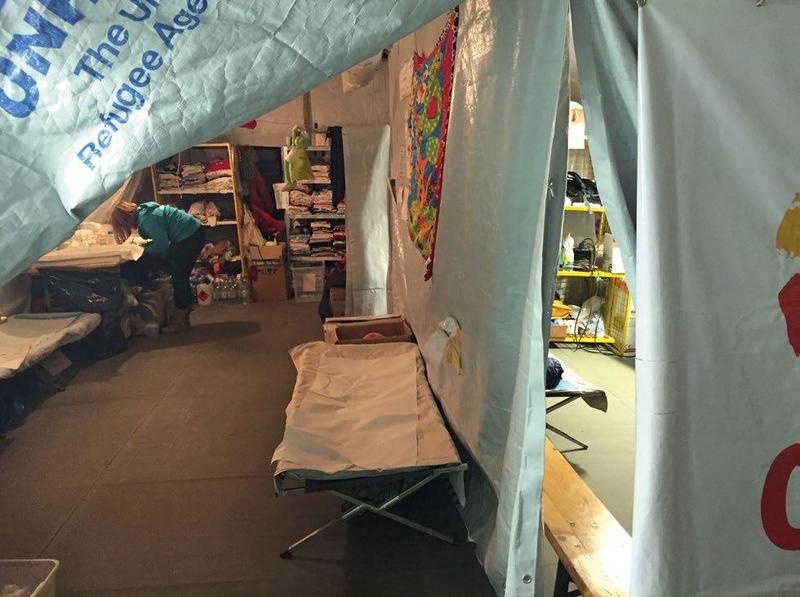Roda Tent
The association Parents in Action (“Roditelji u akciji” – Roda, “Stork” in Croatian) was actively involved in the Opatovac and Slavonski Brod camps with the primary task of providing support for infant and young child feeding in emergencies (IYCF-E). Given their ongoing activities in promoting breastfeeding, their work in the camps focused on supporting breastfeeding for women on the move, as well as a range of other activities to help mothers with infants and young children in transit along the Balkan corridor.
Initially, three Mother and Baby Centers were established in the Slavonski Brod camp in three different sectors: two managed by UNICEF and one by Save the Children, with the medical humanitarian organization MAGNA moving their doctors between these centers. It soon became clear that this method of operation was impractical in terms of time and manpower. When Roda joined these organizations, a single center was established, in a heated tent, which we volunteers who were familiar with Roda’s work called “Roda Tent.” The tent, donated by CARE, was set up next to the distribution tent where most people arriving at the camp were directed, facilitating triage for IYCF-E. Volunteers conducted quick assessments in the distribution tent to identify which pregnant women or mothers with young children needed medical support, a breastfeeding corner or breastfeeding support, diaper changing, hygiene, or clothing for children up to two years old (see Jelušić 2017: 45). The tent itself was divided by screens into three sections where the mentioned activities took place, while the fourth section, the so-called waiting room, was a place where women waited for their turn, and older children and some male family members waited for the mother and baby. As the proportion of women arriving with children at the camp increased at the end of 2015, the need for a quiet corner where they could feed and especially breastfeed their children became more pronounced. At the same time, the rapid pace of transit prevented more extensive counseling on feeding and breastfeeding support, as well as the preparation of powdered formula milk and the sterilization of bottles. However, mothers who breastfed in the Roda Tent received about thirty minutes of peace to feed their child and rest while the volunteers and staff changed the baby. Those whose children were fed by formula received a new bottle and pre-made adapted milk in liquid form, packed in cartons , and could be given a cup for milk, provided by Save the Children (Jelušić 2017: 42).
During my volunteer work in the distribution tent, I often held small children for the women who carried them in their arms while they received clothes, shoes, and hygiene items that were being distributed. I do not recall a single situation where someone did not hand me their child, which I would use as an opportunity to invite them to the Roda Tent. Some women accepted earnestly, while others declined, probably out of fear of being separated from other family members. Outside the Roda Tent, you could often see male family members waiting, sometimes impatiently, and on a few occasions, they asked me to tell their wives to hurry up, as, in their opinion, they had perhaps stayed too long in the warm tent.
Changing the diapers of hypothermic children and replacing their wet and travel-soiled clothes allowed the volunteers and staff in the Mother and Baby Center to assess whether a child needed medical attention. This was particularly frustrating when a child was sick and the parents refused to stay in the camp (cf., e.g., Jelušić 2017: 16; 18). The Roda Tent provided continuous care, 24 hours a day, and according to the manual, it was staffed by employed breastfeeding advisors and volunteers, employed assistants responsible for clothing and hygiene, and others who helped in the Mother and Baby Center and the distribution tent (Jelušić 2017: 40).
Based on the experiences gathered from working in the Opatovac and Slavonski Brod camps, Roda published the manual Support for Breastfeeding and Young Child Feeding in Emergencies. In addition to a chronological account of their activities in the camps, the manual lists missed opportunities and difficulties faced by staff and volunteers, as well as successes that can inform future actions in crisis situations. Moreover, the manual includes a series of statements from collaborators of organizations that were active in the Mother and Baby Center. These statements can be read as testimonies to the arduous journeys many refugees endured, as well as efforts to advocate for and support breastfeeding as one of the few links between the refugees’ and “normal” lives.

Mother and Baby Center, Slavonski brod, December 2016. Photo taken from the manual Support for breastfeeding and young child feeding in emergencies
15/12/2023
Literature
Jelušić, Renata. 2017. Support for breastfeeding and young child feeding in emergencies. Experiences gained during the migrant and refugee crisis in Croatia in 2015 and 2016. . Zagreb: Roda.